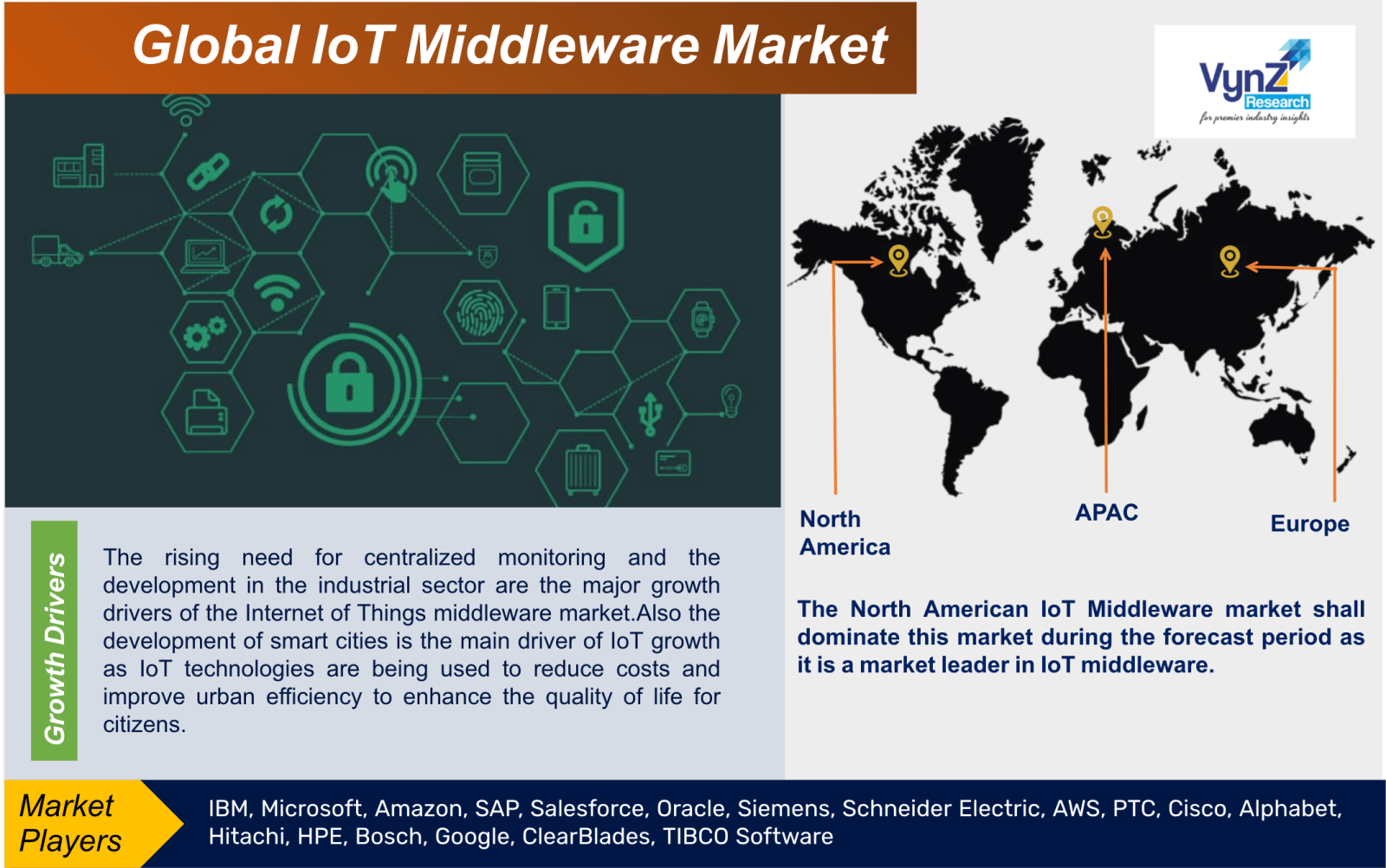| Status : Published | Published On : Sep, 2024 | Report Code : VRICT5185 | Industry : ICT & Media | Available Format :

|
Page : 204 |

Global IoT Middleware Market – Analysis and Forecast (2025-2030)
Industry Insights By Platform (Application Enablement, Device Management and Connectivity Management), By Organization Size (Large Enterprises and Small and Medium-Sized Enterprises), By End User (Manufacturing, Healthcare, Energy and Utilities, Transportation and Logistics, Agriculture and Other End-User Industries) and By Geography (North America, Europe, Asia-Pacific, Latin America, Middle East And Africa)
Industry Overview
The IoT Middleware Market is anticipated to grow from USD 16.8 billion in 2023 to USD 44.2 billion in 2030 at a CAGR of 18.60% during the forecast period from 2025 to 2030.

IoT middleware is a software that is between the hardware and applications layers in an Internet of Things (IoT) system which provides a set of services to manage the interaction and communication between different IoT platforms, devices and applications. An IoT middleware platform is a pivotal intermediary in internet of things, that organize communication between various sensors, devices and systems. IoT middleware enables developers to build reusable IoT applications which reduce cost and the time involved in creating custom solutions from graze. IoT middleware enables the development of IoT applications that can control multiple data platforms and sources that shall enhance the usefulness of the data generated by IoT devices. It also helps to ensure the scalability, reliability and security of IoT applications, enabling them to be deployed in a variety of environments. It functions as the nerve center, enabling device management, data exchange and protocol translation within an interconnected network of IoT devices. IoT middleware plays an essential role in the deployment and development of IoT applications. Without IoT middleware, it would be difficult to manage the vast amount of data generated by IoT devices, and to enable the communication and coordination of different IoT devices and systems.
Market Segmentation
Insight by Platform
- Application Enablement
- Device Management
- Connectivity Management
Based on platform, the global IoT Middleware Market is divided into Application Enablement, Device Management and Connectivity Management. The connectivity management segment dominated the market as it provide a unified platform for managing an organization's whole network and devices that ensures the quality of communication.
Insight by Organization Size
- Large Enterprises
- Small and Medium-Sized Enterprises
Based on organization size, the global IoT Middleware Market is classified into Large Enterprises and Small and Medium-Sized Enterprises. The large enterprises segment account for the highest market revenue as IoT middleware requires huge infrastructure that shall provide huge volume of data with centralized monitoring.
Insight by End User
- Manufacturing
- Healthcare
- Energy and Utilities
- Transportation and Logistics
- Agriculture
- Other End-User Industries
The global IoT Middleware Market is segmented by end user into Manufacturing, Healthcare, Energy and Utilities, Transportation and Logistics, Agriculture, and Other End-User Industries. The manufacturing segment dominated the market as the Internet of things enables manufacturers to link machines and control systems in order to acquire a better knowledge of the production process. The government and Defense category is too expected to grow significantly during the forecast period.
Global IoT Middleware Market Report Coverage
|
Report Metric |
Details |
|
Historical Period |
2018 - 2023 |
|
Base Year Considered |
2024 |
|
Forecast Period |
2025 - 2030 |
|
Market Size in 2024 |
U.S.D. 16.8 Billion |
|
Revenue Forecast in 2030 |
U.S.D. 44.2 Billion |
|
Growth Rate |
18.60% |
|
Segments Covered in the Report |
By Platform, By Organization Size, By End User |
|
Report Scope |
Market Trends, Drivers, and Restraints; Revenue Estimation and Forecast; Segmentation Analysis; Impact of COVID-19; Companies’ Strategic Developments; Market Share Analysis of Key Players; Company Profiling |
|
Regions Covered in the Report |
North America, Europe, Asia-Pacific, Latin America, Middle East And Africa |
Industry Dynamics
Growth Drivers
The rising need for centralized monitoring and the development in the industrial sector are the major growth drivers of the Internet of Things middleware market. Also the development of smart cities is the main driver of IoT growth as IoT technologies are being used to reduce costs and improve urban efficiency to enhance the quality of life for citizens. IoT middleware provides a layer of abstraction that facilitate different IoT platforms, devices and applications to interact and communicate with each other which makes it easier to integrate disparate systems and devices enabling seamless interoperability between them. IoT sensors can adjust traffic lights to reduce congestion & pollution and monitor traffic flow. IoT sensors also optimize waste collection routes which reduce costs improving efficiency. IoT sensors can develop surveillance and emergency response, making cities safer. Furthermore IoT middleware permit the development of reusable and modular IoT applications that can be easily scaled up or down as needed which allows to manage and maintain large-scale IoT deployments where organizations adapt to changing business needs.
Restraints
The major constraint of Iot Middleware Market is the IoT connectivity between devices and products across all industries as current systems do not meet the global connectivity standards which leads to increased complexity and cost in deploying IoT platforms. This is very complicated due to long lifespan of equipment that require costly upgrades to work with latest technologies. Hence, interoperability is critical for the success of products and services that utilize IoT technology. To promote the use of standards, vendors must work together that shall drive IoT development and interoperability.
Opportunities
The integration of advanced technologies such as AI, 5G, edge computing, and blockchain is enhancing the capabilities and applications of IoT systems. With these emerging trends, the IoT market is poised for considerable growth. The market is expected to expand, as consumers and businesses continue to adopt IoT solutions which offer new opportunities for innovation and efficiency in various sectors. The future of IoT looks promising as there is potential for growth and transformation in the IoT sector. The growing adoption of IoT among Small- and Medium-sized Enterprises to achieve higher efficiency at a lower cost, both domestically and internationally is playing an important role that shall create great opportunities in this market. To meet the specific needs of clients across various industries, IoT solution providers are practicing business strategies like strategic acquisitions, to expand their service offerings in the IoT market. Improved agility & scalability, cost reduction, increased revenue along with better performance are encouraging SMEs to adopt these solutions, driving the growth of IoT adoption.
Challenges
IoT presents new risks and challenges as IoT continues to grow day by day. To make IoT services secure and accessible, organizations should overcome various challenges like managing a large number of IoT nodes that requires scalable security solutions and connecting various devices with different capabilities in a secured way. As software becomes more sophisticated and hardware becomes more advanced, new protocols, standards and connectivity options shall become more prevalent. Various types of attacks that include environmental, physical, software, cryptanalysis and cyber attacks where IoT devices are susceptible to. Furthermore, IoT platforms consists of a complex structure, with many devices connected to a network that sends data to the cloud where integrating with existing infrastructure can also make it difficult to implement IoT platforms.
Geographic Overview
• North America
• Europe
• Asia Pacific (APAC)
• Latin America
• Middle East and Africa
Geographically, the IoT Middleware Market is segmented into North America, Europe, Asia Pacific (APAC), Latin America and Middle East and Africa. The North American IoT Middleware market shall dominate this market during the forecast period as it is a market leader in IoT middleware. The growing importance of IoT across the region's critical revenue-generating end-user sectors, such as energy efficiency initiatives, automation for homes, linked autos and an emphasis on innovative manufacturing shall boost the overall market growth.
Competitive Insights
Key players adopted different strategies such as product launch, collaborations and product development. During the forecast period, the market is projected to become more competitive as many companies from various sectors are awaiting to enter the market.
IBM (International Business Machines Corporation) is a multinational technology company that is headquartered in Armonk, N.Y. Company integrates technology and expertise that provides infrastructure, software and consulting services for clients as they pursue the digital transformation of the world.
Microsoft is an American multinational corporation that develops and sells hardware, software and services. By creating technology that changes how people work, play, and communicate, company help people and businesses to reach their potential.
Key Players Covered in the Report
Some of the key players in the IoT Middleware Market are IBM, Microsoft, Amazon, SAP, Salesforce, Oracle, Siemens, Schneider Electric, AWS, PTC, Cisco, Alphabet, Hitachi, HPE, Bosch, Google, ClearBlades, TIBCO Software
Recent developments by Key Players
IBM Corporation is addressing the issue head on with a new product lineup that keeps costs low. The IBM Concert, an automation platform that helps users manage their AI applications, as well as other AI-powered automation tools focus at reducing company spending.
Siemens and Microsoft collaborated with the W3C Consortium to converge the Digital Twin Definition Language (DTDL) with the Thing Description standard from international standards organization, W3C.
The Global Middleware Market report offers a comprehensive market segmentation analysis along with estimation for the forecast period 2025–2030.
Segments Covered in the Report
Region Covered in the Report
- North America
- U.S.
- Canada
- Mexico
- Europe
- Germany
- U.K.
- France
- Italy
- Spain
- Russia
- Rest of Europe
- Asia-Pacific (APAC)
- China
- Japan
- South Korea
- India
- Australia
- Rest of APAC
- Latin America
- Brazil
- Argentina
- Rest of Latin America
- Middle East and Africa
- Turkey
- UAE
- Saudi Arabia
- South Africa
- Rest of MEA
.png)
Source: VynZ Research
.png)
Frequently Asked Questions
Purchase Options
Latest Report
Research Methodology
- Desk Research / Pilot Interviews
- Build Market Size Model
- Research and Analysis
- Final Deliverabvle
Connect With Our Sales Team
- Toll-Free: 1 888 253 3960
- Phone: +91 9960 288 381
- Email: enquiry@vynzresearch.com
IoT Middleware Market
